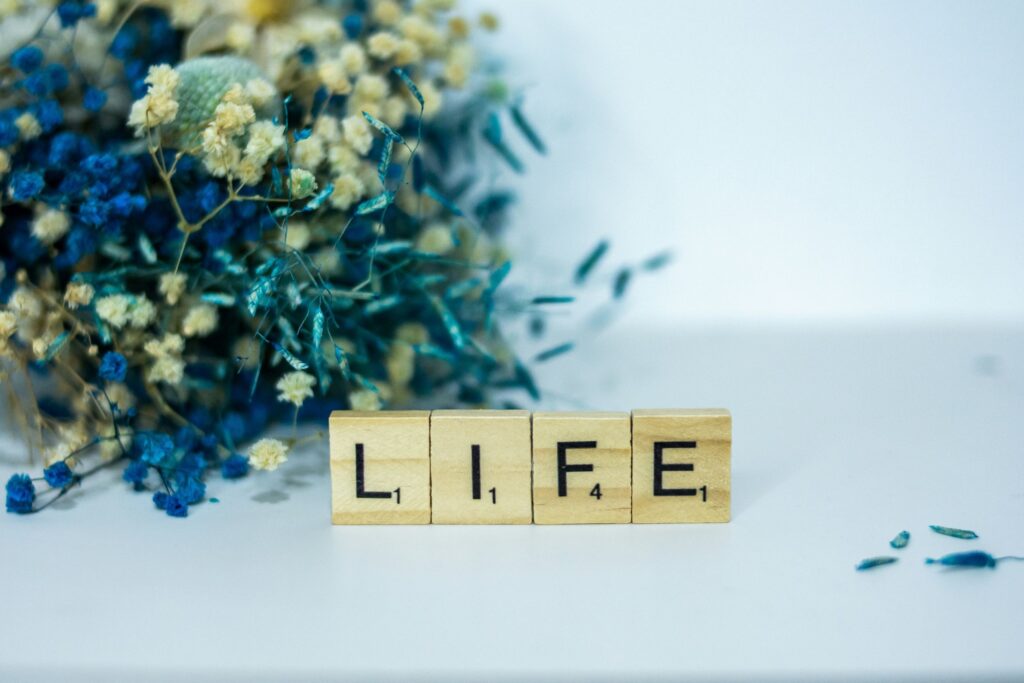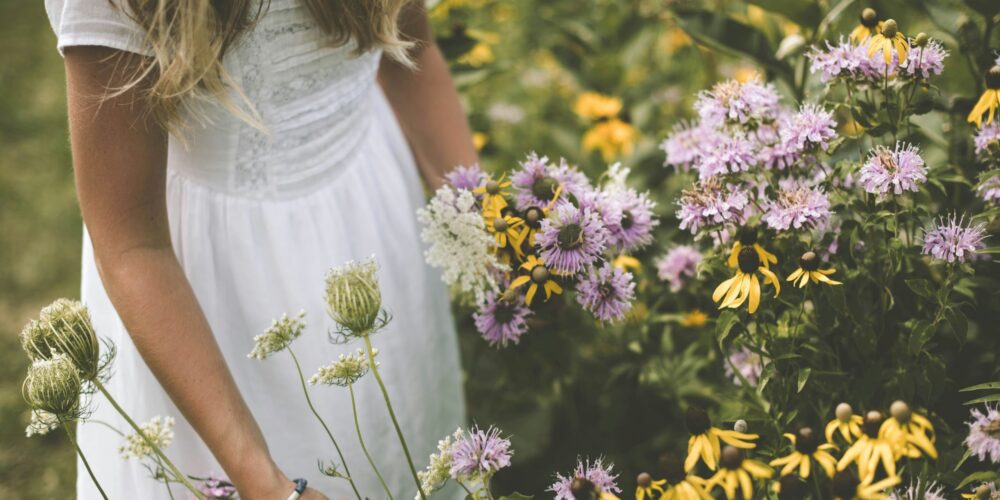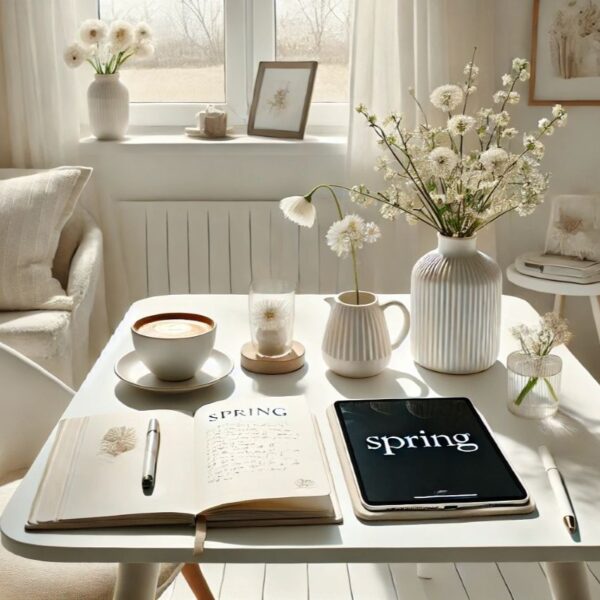One of our favorite YouTube channels we like to watch together is “Living Big In A Tiny House” where the host shares beautiful tiny houses and the stories stories of people who have transitioned from bustling city life in large homes to the minimalist charm of tiny houses.
For most of the people featured in the videos, moving into a tiny house was a deliberate decision to escape the chaos of city life. Earlier they were living in big homes with a lot of stuff and they would spend all their time managing things instead of enjoying life.
But now in their tiny homes, they found a new sense of freedom. With only what they truly needed, they were able to focus on what really mattered. Think about it, living in a tiny house means living with less. It means carefully choosing what to keep and what to let go of. And it’s not just about decluttering, but about living with intention.
Most of them would grow their own food as much as they can, minimize or recycle their waste, and live a sustainable life to reduce their impact on the environment.

Another favorite channel of ours is “Exploring Alternatives” which is about people who’ve left behind the hustle and bustle for a slower and more off-the-grid lifestyle. Some have set up homesteads in rural areas, while others live on boats, remote islands, or in the jungle.
When we watch people living such lifestyles, we often wonder and talk to each other about how different their entire day is as compared to people like us living in big cities. How different is the ecosystem they exist in?
They live so close to nature and spend most of their time with their families doing work like growing food, waste management, etc., and they have very limited interaction with screens.
It is so inspiring to see so many people opting out of the mainstream, tech-driven lifestyle that this modern-day technologically advanced world is leading us towards.
Do we see ourselves leading such a lifestyle where we move to a remote off-grid location away from civilization? Maybe, when we grow old. Who knows?
But one thing we’re certain of is that we definitely want to simplify our lives. We want to break free from the 9-5 grind, focus on what we’re truly passionate about, grow our own food as much as we can, and spend quality time with our friends and family to establish meaningful connections.
Does living in a tiny house or exploring alternatives and moving to an off-grid location mean simple living? Well, it might be for some people and it might not be for others. So what exactly is simple living and how can you benefit from it?
Welcome to our second blog in the “Minimalism and Simplicity” series where we’ll explore exactly this concept. But first, let’s debunk some common misconceptions about simple living.
Table of Contents
What Simple Living Is Not?
1. A Life of Deprivation
Firstly, most people think that simple living is about living a life of deprivation where you sacrifice comfort and convenience, and get rid of all your prized possessions. They can’t be more wrong.
It’s not about denying yourself the joys and comforts of life. Instead, it’s about prioritizing what brings you genuine happiness and fulfillment while letting go of excess that adds little value to your life. It’s about quality over quantity, choosing experiences over material possessions, and finding contentment in what you have.
2. One-Size-Fits-All Approach
Secondly, simple living doesn’t prescribe a rigid set of rules or a one-size-fits-all approach. It’s not about conforming to a specific lifestyle or adhering to a strict minimalist aesthetic.
Instead, it’s about knowing and accepting yourself and finding what works best for you, whether that means living in a tiny house, practicing mindfulness, or living a more sustainable lifestyle.
3. Boring And Lazy
Some people also believe that simple living is boring and it is synonymous with laziness. Having less stuff doesn’t mean you have to sit on the couch binge-watching Netflix all day long.
When you declutter your physical and mental space and prioritize quality over quantity, you have more time and space to be creative, explore, and have meaningful experiences.
4. Escaping From Reality
Some may perceive simple living as a form of escapism, a way to disconnect from the realities of modern life and retreat into a bubble of tranquility.
However, simple living isn’t about escaping life’s challenges or responsibilities. Rather, it’s about facing them head-on with clarity, intention, and purpose. It’s about being present in the moment, appreciating the beauty in simplicity, and being grateful for the little things in life.
5. Ignoring Complexity
Contrary to popular belief, simple living isn’t about ignoring complexity or shying away from the complexities of modern society.
Instead, it is about confronting complexity with simplicity. It is about cutting through the noise and clutter to understand what is truly important.
6. Eliminating Technology
While some might think that simple living is about rejecting technology or returning to the primitive way of living, that isn’t true either.
Simple living is about using technology mindfully and purposefully so you can benefit from its positives and minimize the negatives. It’s about finding a healthy balance between the convenience of modern tools and the calmness of a simpler lifestyle.
7. Instant Fix
Lastly, simple living is not a quick fix to all your life’s problems. You won’t achieve happiness and your problems won’t go away magically overnight.
It is a journey of constant exploration and improvement that will require patience, perseverance, and a willingness to continuously improve.
Why Is It Important to Simplify Your Life??
In our modern world, we are bombarded with constant distractions from all directions. From the moment we wake up, tons of notifications, emails, tasks, and responsibilities cry for our attention.
Companies with strong PR strategies try very hard to convince us that we need more, that our happiness depends on the next purchase, and that our worth is dependent on the things we own.
As a result, our homes are filled with things we barely use or even remember we have. We invest significant time and effort into managing and maintaining things that add little to no value to our lives. Our spaces have become cluttered, both physically and mentally, and there is very little room for clarity and peace of mind.
Our definition of success and happiness has changed because of societal influences and social media. We try very hard to look happy and successful just like everyone else on social media and as a result, we end up buying fancy gadgets and expensive stuff at the cost of our financial well-being and emotional health.
All this is just for external validation from the people who don’t matter at all.
After working hard all week, we long for weekends so we can party and blow off some steam. But before we know it, the weekend is over and the same Monday blues hit us again.
This fast-paced and consumer-driven lifestyle has severe health consequences as many of us experience high stress, anxiety, and burnout. Mental and physical health problems are on the rise because of our sedentary habits, poor eating choices, and inadequate self-care coupled with societal pressure and unrealistic expectations.
Amidst this chaos, there is a strong need to simplify our lives and break free of this lifestyle where we direct all our time and energy on things that don’t matter.
Let’s explore what simple living is and how you can bring simplicity into your everyday life.
What Does It Mean to Live a Simple Life?
Living a simple life isn’t about rejecting the comforts and convenience of the modern world. Instead, it’s a deliberate choice to remove the distractions and focus on what truly matters. Each one of us has a unique image of the best version of ourselves and the kind of life we want to lead. But only a few of us actively work toward that vision.
A simple life means streamlining and decluttering your life, both physically and mentally, so that you can focus on manifesting your dream life and becoming the best version of yourself.
This lifestyle isn’t about sacrificing happiness or necessities. It’s about being mindful of what adds value to your life and what doesn’t. It’s about letting go of all the unnecessary distractions, possessions, thoughts, and negative people that might hold you back.
Living simply means aligning your actions with your values. It’s about spending time on activities and with people who are positive and supportive. It’s not about rejecting technology or convenience but using them purposefully and in moderation.
For example, having a smartphone isn’t against simple living. It’s about using it wisely and not letting it consume your every moment. It’s using technology to improve your life, not detract from it. Simple living is about finding balance and prioritizing what truly matters to you.
Imagine a life where you wake up with a clear mind, free from the noise of unnecessary worries. A life where you have time to pursue your passions, nurture relationships, and savor moments of joy. This is the essence of simple living – a life crafted intentionally and focused on what brings genuine happiness and meaning.
How Is Minimalism Connected With Simple Living?
At first glance, minimalism and simple living might seem like two peas in a pod, and in many ways, they are. Both philosophies share a common goal – to pare down the excess and focus on what truly matters. However, while they share similarities, they are not one and the same.
Minimalism is more about owning fewer possessions and living with less. It’s about decluttering your physical spaces and eliminating anything that doesn’t serve a purpose or bring you joy. Minimalists prioritize quality over quantity and seek to simplify their lives by reducing material possessions to the essentials.
On the other hand, simple living is a broader approach to life. It’s not just about minimizing possessions, it’s about simplifying all aspects of your lives, including your schedules, commitments, and mental clutter.
While minimalism focuses primarily on material possessions, simple living extends beyond physical clutter to your relationships, finances, and overall lifestyle choices. It encourages you to slow down, savor life’s moments, and cultivate gratitude for what you have.
Despite their differences, minimalism and simple living often go hand in hand. Many minimalists embrace simple living principles as a natural extension of their minimalist lifestyle.
The concepts of minimalism and simple living are deeply intertwined with each other. Ultimately, whether you identify yourself as a minimalist, an advocate of simple living, or a combination of both, the key is to find a lifestyle that aligns with your values and brings you fulfillment.
What Are the Benefits of a Simple Life?
A simple life has immense benefits for your overall health and well-being. If you lead a simple life that is tailored to your unique preferences and lifestyle, it will benefit you in various aspects of your life. Let’s take a closer look at some of these benefits.
1. Reduced Stress and Anxiety
As human beings, we’re blessed to experience the full spectrum of emotions, from happiness and joy to sadness and anxiety. If you’re thinking that simple living will magically erase all the negative emotions from your life, you would be setting false expectations.
Negative expressions are a normal part of life and as long as you’re alive, there will be days when you’ll feel stressed and anxious. These emotions and feelings will completely go away only when you’re dead.
However, when you start living a simple life, the frequency and intensity of these negative emotions will drastically come down.
In today’s world, stress mostly comes from the demands and distractions of the modern-day lifestyle and you’ll experience it a lot less when you transition to a simpler life.
2. More Time and Freedom For Creativity
Everyone wants to be successful in life and become the best version of themselves but most of us don’t have enough time and freedom to work in that direction.
Living a simpler life means eliminating all the unnecessary things from all aspects of your life which will give you a lot of time and freedom to show your creativity and work on the things you’re really passionate about.
With fewer obligations to weigh you down, you’ll have enough time to work towards your dreams and goals, spend time with your loved ones, and do the activities that bring you joy and nourish your mind and body.
3. Better Quality of Life
When you’re life is less stressful and you have enough time to work on your dreams and take care of your mind and body through self-care, your overall quality of life improves.
Every action you take becomes intentional and will give you a sense of fulfillment and contentment in your daily life.
4. Better Relationships
A simpler life benefits your relationships as well, whether it is your partner and family or your friends. The concept of simple living encourages you to prioritize meaningful connections.
It gives you enough time to engage in in-person conversations and activities rather than virtual connections. You can use that time to nurture friendships, spend quality time with family, and build deeper connections with your loved ones.
With fewer distractions and a focus on what’s important, you communicate better, listen more attentively, and appreciate the people around you which leads to healthier, happier, and more fulfilling relationships.
5. Improved Financial Well-Being
Simple living means cutting down on unnecessary expenses and living within your means. It encourages you to become more mindful of your spending habits and prioritize spending on things that truly add value to your lives.
This lifestyle leads to reduced financial stress and a more sustainable financial outlook. You focus on saving for meaningful goals rather than accumulating things that may not give you long-term happiness.
Simple living also encourages you to adopt frugal practices such as repairing items instead of always buying new ones, cooking at home instead of dining out frequently, etc.
6. Greater Environmental Sustainability
Simple living also encourages you to adopt eco-friendly practices that reduce your impact on the environment. You become more mindful of your consumption patterns, waste generation, and overall resource utilization.
One key aspect of simple living is reducing unnecessary consumption, which in turn decreases the demand for things that lead to environmental degradation during production, transportation, and disposal.
How Do I Start Simple Living?
When you start on the journey of living a simple life, you start by identifying the aspect of your life that feels the most cluttered or overwhelming. This could vary from person to person as each one of us has different priorities and challenges.
For some, it might be the chaotic schedule that leaves them feeling constantly busy and drained, for others, it might be their physical surroundings or their mental space.
If you feel that you have a chaotic schedule and it is the first thing you want to simplify, start by reassessing commitments, prioritizing important tasks, and creating boundaries to protect your time and energy.
If it’s your physical space, start by decluttering and organizing the space around you. Start mindfulness practices such as mindfulness meditation if it’s your mental space.
The key is to focus on the area of your life that is causing the most stress or dissatisfaction. Simple living is not about making a single decision but rather adopting a lifestyle that aligns with your values and priorities.
It’s about customizing your approach to suit your unique needs and desires, emphasizing what truly matters to you, and letting go of the rest.
Wrapping Up – Living The Simple Life
Simple living is a concept that means different things to different people. Each one of us will have a different image of simple living. For some, it could be homesteading away from the city, living in a tiny house in a remote location, or cultivating a farm away from city life.
For others, it might just be decluttering their physical and mental space so that there is room for peace and calmness. Different people have different versions.
The beauty of simple living is that it is adaptable and can be personalized according to your unique preferences and lifestyle. It doesn’t have a fixed set of rules or a one-size-fits-all approach. Each one of us can define what a simple life means to us and take steps toward realizing that vision.
As we’ve learned in this blog, simple living has a number of benefits, from reduced stress and improved well-being to greater financial freedom and environmental consciousness. While it won’t be easy at first and you can’t transition to a simple life over the weekend, every small step you take will bring you closer to intentional living.
It’s all about taking control of your choices and making decisions with purpose rather than just reacting to them.
Our next blog will be on tips or steps to simplify your life and we invite you to join us in that blog. Also, share with us your version of a simple life and how you incorporate simple living into your daily routine. Namaste!







Leave a Reply